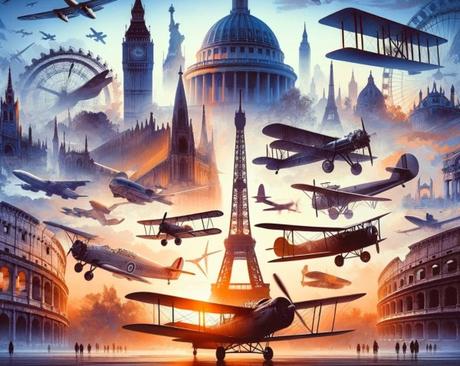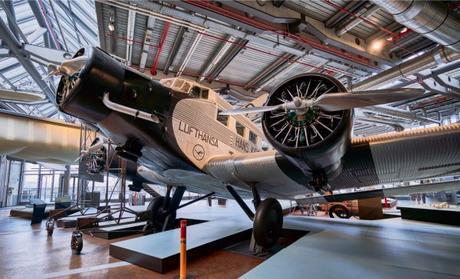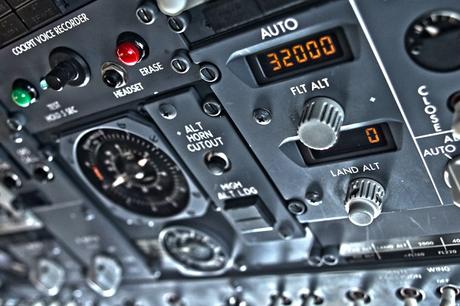
Europe’s aviation history is as diverse as it is fascinating, and its museums offer an unparalleled glimpse into this captivating world. From the pioneers of flight to the marvels of modern aerospace, these museums are must-visit destinations for anyone interested in the history and future of flying.
Traveling through Europe is as much about the journey as the destination, especially with its exemplary rail network. Taking the train from Munich to Vienna is not just a mode of transport but an experience in itself. These trains glide through some of Europe’s most breathtaking landscapes, offering views that are as memorable as the destinations. The convenience of these rail services makes it easy to weave through major cities, turning a trip to Europe’s aviation museums into a grand tour of cultural and historical significance.
The Vienna Technical Museum, Vienna, Austria:
After the scenic Vienna to Salzburg train journey, this museum is a wonderful stop. It features an extensive range of exhibits from Austria’s technological history, including a fascinating aviation section with aircraft and engines that chart the country’s aeronautical advancements.
The Royal Air Force Museum, London, UK:
This prestigious museum celebrates the history of the Royal Air Force with a collection that spans over a century. Visitors can explore five major buildings and hangars displaying over 100 aircraft, including the legendary Spitfire and Lancaster Bomber. Interactive exhibits and educational programs make it a perfect destination for families and enthusiasts alike.
The Deutsches Museum, Munich, Germany:

Nestled in the vibrant city of Munich, the Deutsches Museum stands as a beacon for those passionate about science and technological advancements. Its aviation wing is particularly compelling, offering a journey through the annals of flight. Visitors can witness the pioneering spirit of the Wright brothers through their Flyer, a testament to the dawn of aviation. Equally impressive is the Messerschmitt Me 262, a pivotal design in jet aircraft history, bridging the gap between past and future. The museum’s diverse collection, covering both civilian and military aviation, paints a vivid picture of Germany’s pivotal role in the aerospace sector.
The Aviation Museum, Krakow, Poland:

Tucked away in Krakow, this museum is a haven for aviation historians and enthusiasts alike. It holds a remarkable collection of aircraft from the Soviet era, offering a unique perspective on Cold War aviation. The museum’s assortment of gliders and WWII aircraft adds depth to its narrative, showcasing the evolution of flight technology through tumultuous times. A standout feature is the comprehensive display of MiG fighters, chronicling the development of these legendary jet fighters. Each exhibit at the museum not only displays an aircraft but tells the story of its era, the people who built and flew them, and their impact on the course of history.
The French Air and Space Museum, Paris, France:
Located in the historic Le Bourget Airport, the French Air and Space Museum is a treasure trove of aviation history. Its halls are adorned with some of the most significant aircraft in history, like the sleek Mirage jets, symbols of French aeronautical ingenuity. The museum’s space exploration section is equally fascinating, featuring a life-size model of the Ariane 5 rocket, a beacon of European space endeavors. Visitors can immerse themselves in a world where the boundaries of air and space blur, exploring an array of space artifacts that narrate the story of humanity’s quest beyond our planet.
The Aviodrome, Lelystad, Netherlands:
More than a museum, the Aviodrome is an interactive aviation theme park. It features over 100 aircraft, including a Boeing 747 that visitors can board. The museum also offers flight simulators and a 4D movie theater, making it an engaging experience for all ages.
The Italian Air Force Museum, Vigna di Valle, Italy:
Set against the picturesque backdrop of Lake Bracciano, this museum showcases the history of the Italian Air Force. Highlights include WWI fighters, WWII bombers, and jet age fighters, each telling a story of Italy’s rich aviation history.
The Swiss Transport Museum, Lucerne, Switzerland:
This museum offers a holistic view of transportation, including aviation. The air and space section includes historical aircraft, helicopters, and a space exhibition with a focus on Swiss contributions to space technology.
The Brussels Air Museum, Brussels, Belgium:
Situated in the historic Cinquantenaire Park, this museum boasts a collection that ranges from early aviation experiments to modern aircraft. Special attractions include rare WWI planes and a significant collection of jet fighters from the Cold War era.
The Spanish Air Force Museum, Madrid, Spain:
In the vibrant capital city of Madrid, the Spanish Air Force Museum serves as a custodian of Spain’s rich aviation heritage. This museum is a journey through time, showcasing the evolution of Spanish aviation from the pioneering days of wood-and-fabric biplanes to the sleek agility of contemporary jets. Among its prized exhibits is the Heinkel He 111, a key player in the Spanish Civil War, offering a stark reminder of the era’s tumultuous skies. The museum’s collection is a vivid tapestry that narrates the story of Spain’s progress and prowess in the field of aviation, making it a must-visit for anyone fascinated by the history of flight.
Conclusion:
The aviation museums scattered across Europe are more than mere repositories of aircraft; they are vibrant narrators of a saga that spans human ambition, technological prowess, and the relentless pursuit of pushing boundaries. Each museum is a portal to a different time and place, offering insights into the eras they represent and the visionaries who propelled humanity into the skies. For the aviation enthusiast, the curious traveler, or the history buff, these museums offer an enriching and enlightening journey, one that celebrates the legacy and future of flight.

